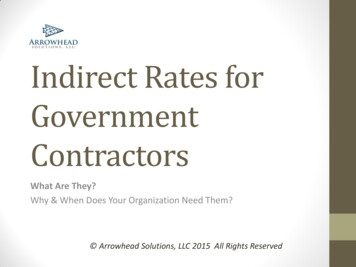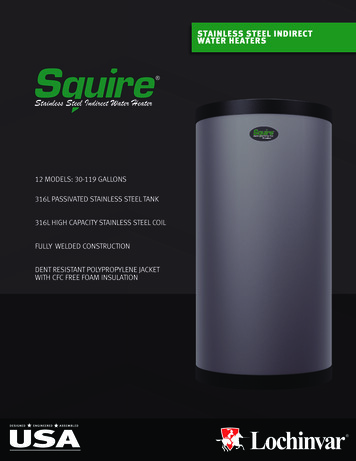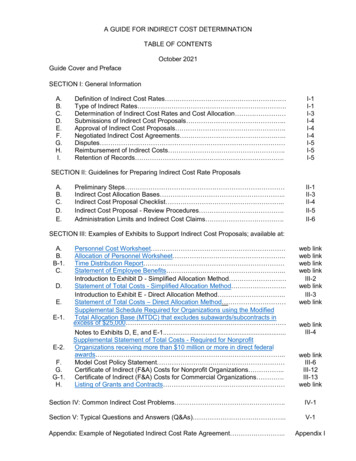
Transcription
Indirect Rates forGovernmentContractorsWhat Are They?Why & When Does Your Organization Need Them? Arrowhead Solutions, LLC 2015 All Rights Reserved
Objectives Present a High Level Overview of Indirect Rates This is a 10,000 foot view of Indirect Rates We will be discussing what they are, why it is necessary tounderstand them and when you should be employing them. This is not a tactical discussion so we won’t specifically defineand calculate the rates. Arrowhead Solutions, LLC 2015 All Rights Reserved
What Are Indirect Costs?First - Distinguish Between Direct & Indirect Costs: Direct Costs: Labor, materials, travel, subks, ODCs directlyattributable to a product or service direct contract costs. i.e. John provides engineering services for contract XY4567 – the costof his time working on the contract is a direct cost. Indirect Costs: Indirect costs are expenses that are incurred by thecompany, but are not directly associated with a contract or thedelivery of a product or service, such as: Cost of employee benefits It costs the company 100 / month in insurance expense to contribute tohealth insurance for employees Costs of maintaining an office (rent, utilities, etc) Costs of indirect labor: Jane is the Accountant for the company – the cost of her time is anindirect cost John the engineer, who went to a company paid seminar– this time isindirect labor . Arrowhead Solutions, LLC 2015 All Rights Reserved
What are Indirect Rates? Indirect rates - are the indirect costs expressed as a % of thebase of costs which they benefit. Fringe, Overhead and G&A are most common Example – what is Fringe? Fringe are costs such as health care, payroll taxes, 401(k)matching contributions and other employer – borne costs ofemployment. This is called the “pool”. Assuming all employees are eligible for the same benefitspackage, the base over which fringe benefits are spread is TotalWages (Direct and Indirect). This is called the “base” Fringe Rate : Total Fringe benefits (pool) / total wages (base) Arrowhead Solutions, LLC 2015 All Rights Reserved
Why Understanding Rates is SoImportantBecause :“You can’t manage what you can’t measure !”W Edwards Demming Arrowhead Solutions, LLC 2015 All Rights Reserved
Importance Managing costs effectively in your company (and making aprofit): Irrespective of Contract type your organization incurs indirectcosts. If you do NOT know how to measure or manage them, you may ormay not be making a profit. Certainly your income statement shows your “bottom line” forthe year, but are you making a profit on your multi yearcontracts? Arrowhead Solutions, LLC 2015 All Rights Reserved
Importance Identifying cost components and developing competitive costproposals: Let’s consider a Time and Materials Cost Proposal: If we assumeJohn is paid a base wage of 100.00 / hour; at what rate must thecompany bill out John’s time in order to cover its costs? The T&M rate at which we bill John’s time must cover: (A) His base wage(B) Associated fringe or overhead(C) G&A expenses incurred by the organization(D) Profit Do you know how to calculate this T&M rate ? By identifying the component costs and grossing up John’s rate tocover these costs. The rate which covers (B) and (C) is the “wrap rate” Arrowhead Solutions, LLC 2015 All Rights Reserved
What is a “Wrap Rate” ? The term wrap rate refers to the effective multiplier that isnecessary to cover the cost of direct labor. In other words . The rate at which 1 of direct labor must bebilled out at in order to cover all of the associated indirect rates.A brief illustration:Labor 100.00/hr (B) Fringe Rate is 10% (C) G&A Rate is 25%Wrap Rate is (1.10) * (1.25) 1.375Therefore we must bill John out at ( 100 * 1.375) 137.50 beforeprofit to cover our indirect costs. Arrowhead Solutions, LLC 2015 All Rights Reserved
When do you Need Rates? You must have them in order to bid on and invoice against aCost Type contract! Measurable Indirect Rates are Required to bid on governmentCost type contracts Approved rates are required to invoice on Cost Type Contracts.Caution: Although indirect rates are not specifically approvedbefore an FFP or T&M proposal review, many proposals require youto disclose the rates in your pricing data backup; therefore youshould know them and not just guess at them. Arrowhead Solutions, LLC 2015 All Rights Reserved
When do you Need Rates? You absolutely should have them as soon you start doingbusiness – WHY ? The organization should have a thoughtful budgeting processeach year to identify and plan its direct and indirect costs. Actual costs should be monitored against the budgeted costs,minimally on a quarterly basis. If you don’t know what your costs are how will you ensure youare making money on a contract or series of contracts?Indirect costs are a crucial component to managing costs –take the time to understand them and manage them. Arrowhead Solutions, LLC 2015 All Rights Reserved
Questions?Or do you need help calculating your rates? Let us help.Email: olutionsllc.com Arrowhead Solutions, LLC 2015 All Rights Reserved
The term wrap rate refers to the effective multiplier that is necessary to cover the cost of direct labor. In other words . The rate at which 1 of direct labor must be billed out at in order to cover all of the associated indirect rates. A brief illustration: Labor 100.00/hr (B) Fringe Rate is 10% (C) G&A Rate is 25% Wrap Rate is .










